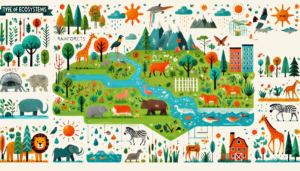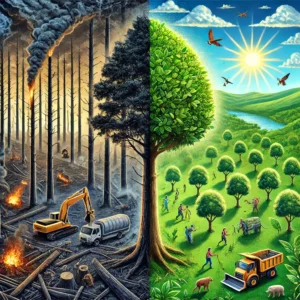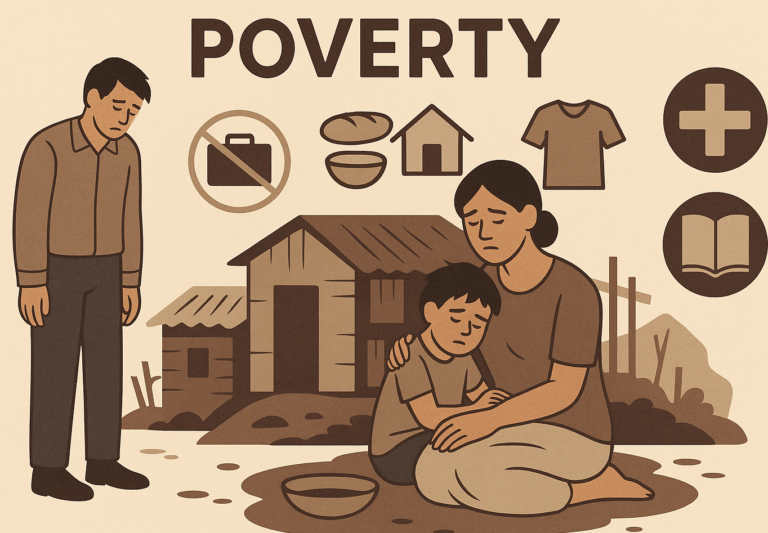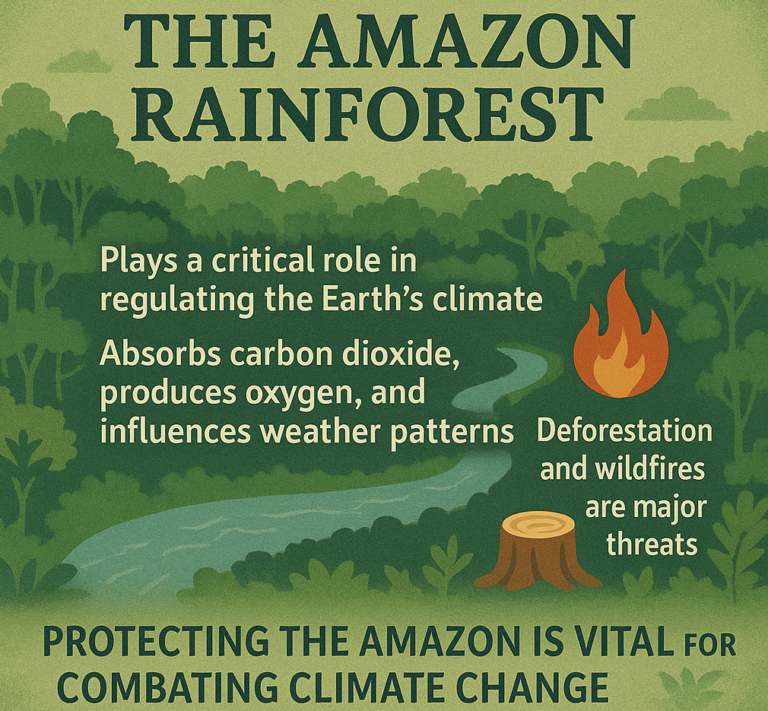The Importance of the Amazon Rainforest in Climate Regulation
The Amazon Rainforest, often called “the lungs of the Earth,” is one of the most important ecosystems on the planet. It covers much of Brazil and parts of other South American countries like Peru, Colombia, and Venezuela. The Amazon plays a crucial role in regulating the Earth’s climate and is vital for maintaining the balance of nature.

1. What is the Amazon Rainforest?
- The Amazon Rainforest is a vast area of tropical forest, covering about 5.5 million square kilometers (2.1 million square miles). It’s home to a huge variety of plants, animals, and indigenous communities.
- It’s called a “rainforest” because it gets a lot of rain throughout the year. The trees, plants, and wildlife create a complex and interconnected ecosystem.
2. The Amazon as a Carbon Sink
- One of the most important functions of the Amazon is its role as a carbon sink. This means the forest absorbs more carbon dioxide (CO₂) from the atmosphere than it releases.
- Carbon dioxide is a major greenhouse gas that traps heat in the Earth’s atmosphere, contributing to global warming. When the Amazon absorbs CO₂, it helps to reduce the effects of climate change by keeping more carbon out of the air.
3. How Does the Amazon Help with Climate Regulation?
- Absorbing Carbon Dioxide:
- Trees and plants in the Amazon absorb CO₂ during photosynthesis, the process by which plants convert sunlight into energy. The Amazon rainforest absorbs about 1.5 billion tons of CO₂ each year!
- By removing CO₂ from the atmosphere, the Amazon helps to slow down the greenhouse effect, which causes the planet to warm up.
- Producing Oxygen:
- In return for absorbing CO₂, plants release oxygen (O₂) into the atmosphere. This is important because oxygen is what humans and animals breathe to survive.
- The Amazon produces about 20% of the world’s oxygen, which means it plays a big part in maintaining the balance of gases in the atmosphere.
4. The Amazon’s Role in Weather Patterns
- Regulating Rainfall:
- The Amazon also influences weather patterns both locally and globally. Trees in the forest release water vapor into the air through a process called transpiration. This helps create clouds and increases rainfall, which is vital for agriculture and drinking water in the surrounding regions.
- In fact, the Amazon plays such an important role in the water cycle that if it is destroyed, regions far beyond the rainforest could experience droughts and water shortages.
- Maintaining Global Climate Stability:
- The Amazon helps regulate temperature and rainfall across large parts of the globe. If the forest were to disappear, the loss of this climate regulation could cause extreme weather events like heatwaves, droughts, and stronger storms.
5. Biodiversity and Climate Resilience
- Rich Biodiversity:
- The Amazon Rainforest is home to an astonishing amount of biodiversity—millions of species of plants, animals, and insects. This biodiversity is essential for the stability of the ecosystem. For example, the diversity of plants helps maintain the forest’s ability to absorb CO₂ and regulate water flow.
- Resilience to Climate Change:
- The variety of species in the Amazon helps the ecosystem stay resilient (strong and adaptable) to climate changes. The different plants and animals support each other and help keep the ecosystem balanced, making it more able to recover from disturbances like storms or droughts.
6. Threats to the Amazon and Climate Impact
- Deforestation:
- The Amazon is under threat from deforestation (cutting down trees) for logging, farming (like cattle ranching), and mining. When trees are cut down, they stop absorbing CO₂, and the carbon stored in the trees is released back into the atmosphere. This accelerates climate change.
- Deforestation also reduces the number of trees that produce oxygen and rain, which disrupts weather patterns and can lead to desertification (turning areas into deserts).
- Wildfires:
- Wildfires, often caused by humans clearing land for farming, are another major threat to the Amazon. These fires destroy large areas of the forest and release huge amounts of CO₂ into the atmosphere.
- In recent years, fires have become more common in the Amazon, further weakening its ability to regulate the climate.
7. The Global Impact of the Amazon’s Decline
- If the Amazon continues to shrink, the effects will be felt globally:
- Worsening Climate Change: Without the Amazon’s carbon-absorbing ability, there will be more CO₂ in the air, which will increase global warming. This could lead to higher temperatures, rising sea levels, and more extreme weather events like hurricanes and droughts.
- Disruption of Rainfall Patterns: Loss of the Amazon could lead to changes in weather, like droughts in areas that rely on rainfall from the forest. This would affect food production, water supplies, and the livelihoods of millions of people.
- Loss of Biodiversity: The destruction of the Amazon means the loss of countless plant and animal species, many of which might never be seen again. This loss of biodiversity weakens the resilience of the global ecosystem, making it harder for nature to recover from environmental changes.
8. Why We Need to Protect the Amazon
- Combating Climate Change: Protecting the Amazon is crucial for fighting climate change. By keeping the forest intact, we can continue to rely on its ability to absorb CO₂ and stabilize the climate.
- Sustaining Life on Earth: The Amazon is not just important for the local communities living within it, but for everyone on Earth. The oxygen it produces, the water it cycles, and the climate regulation it provides benefit the whole planet.
- Preserving Biodiversity: Saving the Amazon helps preserve biodiversity, which supports agriculture, medicine, and natural ecosystems. Many modern medicines are derived from plants found in rainforests like the Amazon, so losing these species could mean losing important treatments for diseases.
9. What Can We Do to Help?
- Support Conservation Efforts: Organizations around the world are working to protect the Amazon. Supporting them by donating or raising awareness helps fund efforts to stop deforestation and protect the forest.
- Sustainable Products: Choose products that are sustainably sourced, such as palm oil, soy, and wood that don’t contribute to deforestation in the Amazon.
- Reduce Carbon Footprint: Reducing your personal carbon footprint by using less energy, driving less, and consuming less meat can help fight the effects of climate change.
- Advocate for Policy Change: Support policies and leaders who prioritize the protection of the Amazon and other critical ecosystems around the world.
In Summary:
- The Amazon Rainforest plays a critical role in regulating the Earth’s climate by absorbing carbon dioxide, producing oxygen, and influencing weather patterns.
- The forest helps stabilize the global climate, promotes rainfall, and supports biodiversity.
- Deforestation and wildfires are major threats to the Amazon, and their destruction accelerates climate change.
- Protecting the Amazon is vital for combating climate change, preserving biodiversity, and ensuring a stable future for the planet.








